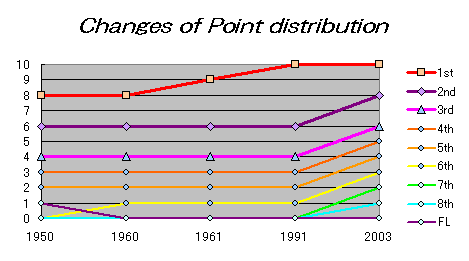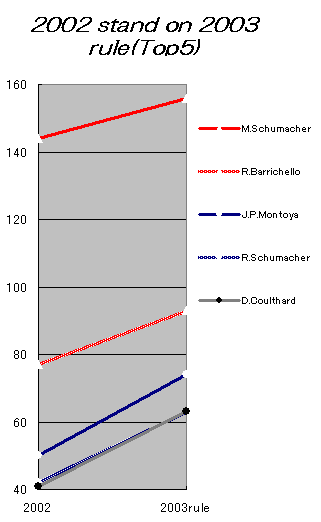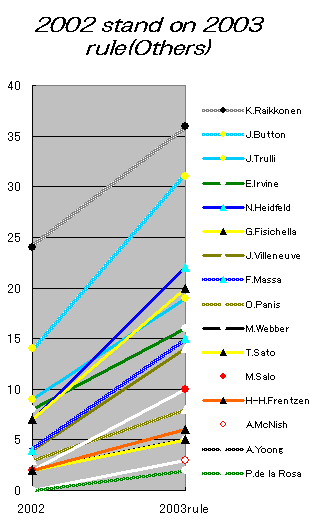 FIA reformed the point distribution method for the first time in 12 years on
October 28, 2002. It changed to 10-8-6-5-4-3-2-1 from 10-6-4-3-2-1. How is a
championship influenced? It turned round from the past point distribution
method.
FIA reformed the point distribution method for the first time in 12 years on
October 28, 2002. It changed to 10-8-6-5-4-3-2-1 from 10-6-4-3-2-1. How is a
championship influenced? It turned round from the past point distribution
method.ポイント配分の変遷 1位の価値が低下
Nov. 3rd, 2002
 FIA reformed the point distribution method for the first time in 12 years on
October 28, 2002. It changed to 10-8-6-5-4-3-2-1 from 10-6-4-3-2-1. How is a
championship influenced? It turned round from the past point distribution
method.
FIA reformed the point distribution method for the first time in 12 years on
October 28, 2002. It changed to 10-8-6-5-4-3-2-1 from 10-6-4-3-2-1. How is a
championship influenced? It turned round from the past point distribution
method.
2002年10月28日、FIAはポイント配分方法を12年ぶりに改定しました。これまでの10-6-4-3-2-1から、10-8-6-5-4-3-2-1としました。チャンピオンシップはどのように影響されるでしょうか。過去のポイント配分方法から振り返ってみました。
43年ぶりに1位と2位が2点差に縮まる
| 1st | 2nd | 3rd | 4th | 5th | 6th | 7th | 8th | FL | |
| 1950-1959 | 8 | 6 | 4 | 3 | 2 | 1 | |||
| 1960 | 8 | 6 | 4 | 3 | 2 | 1 | |||
| 1961-1990 | 9 | 6 | 4 | 3 | 2 | 1 | |||
| 1991-2002 | 10 | 6 | 4 | 3 | 2 | 1 | |||
| 2003- | 10 | 8 | 6 | 5 | 4 | 3 | 2 | 1 |
 1950,
it was distributed with 8-6-4-3-2 by the 5th place, and one point was given to
the fastest lap (FL). The number of the differences of the 1st place and the 2nd
place is two. One point changed to the 6th place in 1960 after FL.
1950,
it was distributed with 8-6-4-3-2 by the 5th place, and one point was given to
the fastest lap (FL). The number of the differences of the 1st place and the 2nd
place is two. One point changed to the 6th place in 1960 after FL.
The 1st place became nine points 1961, and the difference with the 2nd place became three points. The distribution method did not change this in for 30 years.
The 1st place became ten points from nine points 1991. This was exchange to all race effective score system. The difference of the 1st place and the 2nd place spread in four points.
Since the bottom raising less than of the 2nd place will be carried out two points at a time in 2003, it is shortened by the difference of the 1st place and the 2nd place to a two point difference for the first time in 43 years.
In the past, the history of score distribution was what worth of the 1st place goes up. Ferrari had its own way in 2002, the team order was taken out, and people's interest has faded. F1 contracted the 1st place and the 2nd place, and returned it to the difference of the 1950s again.
The score to the 7th place and the 8th place will say that it is the first in in history. It is because the chance where three or so rates of complete running increased, and a low rank team won a prize decreased.
1950年は1位から5位までに8-6-4-3-2と配分され、ファステストラップ(FL)に1点が与えられました。1位と2位の差は2点です。1960年に1点はFLから6位に変わりました。
1961年に1位が9点になり、2位との差が3点になりました。これは30年間におよんで配分方法は変わりませんでした。
1991年、1位が9点から10点になりました。これは、全戦有効得点制との引き換えのようなものでした。1位と2位の差は4点に広がりました。
2003年、2位以下が2点ずつ底上げされるため、1位と2位の差は43年ぶりに2点差に縮まります。
過去において得点配分の歴史は1位の価値が上がっていくものでした。2002年にフェラーリが独走し、チームオーダーが出され、人々の興味が薄れてきました。F1は1位と2位を縮め、再び1950年代の差に戻しました。7位と8位への得点は、史上初ということになります。3強の完走率が高まり、下位チームが入賞するチャンスが減ったためです。
 Alex
Yoong was the 7th place in 2002 Australian GP. Supposing it is a rule in 2003,
it means that he had gained the point.
Alex
Yoong was the 7th place in 2002 Australian GP. Supposing it is a rule in 2003,
it means that he had gained the point.
アレックス・ユーンは2002オーストラリアGPで7位でした。もし2003年のルールだったら、ユーンはポイントを獲得していたことになります。

If the championship in 2002 is re-calculated by the point distribution method in 2003, what does it become?
Schumacher becomes 156 points, and the difference with Barrichello changed to 64 points from 67 points, and it is not influential many.
Montoya of the 3rd rank does not change, either. Although Ralph of the 4th rank becomes Coulthard of the 5th rank, and a tie, Ralph exceeds by the number of the 4th rank.
仮に2003年のポイント配分方法で2002年の選手権を再計算してみるとどうなるでしょうか。
シューマッハは156点になり、バリチェロとの差は67点から64点に変わったくらいで、大勢に影響はありません。
3位のモントーヤも変わらず。4位のラルフが5位のクルサードと同点になりますが、4位の数でラルフが上回ります。 The
6th rank Raikkonen and the 7th rank of Button does not change, either.
The
6th rank Raikkonen and the 7th rank of Button does not change, either.
To the 8th rank, Heidfeld goes up from the 10th. Heidfeld had the 7th 3 times and the 8th 1 time.
Fisichella also goes up from the 11th rank to the 9th. Fisichella also had the 7th 2 times and 8th 1 time.
Salo goes up from the 17th rank to the 14th. Salo had 7th 1 time and 8th 2 times.
Except 5th grades of Japanese GP, there is only the 8th one place and Sato is descent from the 15th rank at the 17th rank.
In the person who has not scored, McNish will acquire three points, Yoong and de la Rosa will acquire two points.
6位ライコネンと7位バトンも変わらず。8位にはハイドフェルドが10位から上昇。ハイドフェルドは7位3回と8位1回がありました。
フィジケラも11位から9位に上昇。フィジケラも7位2回と8位1回がありました。
サロは17位から14位に上昇。サロは7位1回と8位2回がありました。
佐藤は日本GPの5位以外は8位が1回しかなく、15位から17位に下降です。
ポイントを上げられなかった者のうち、マクニッシュが3点、ユーンとデ・ラ・ロサが2点を獲得することになります。
The driver may be fought under the occasional rule and it may be meaningless to have applied the rule in 2003 in the past. However, it can hear about how argument of a championship changes. The past ten years were re-calculated with the rule in 2003.
ドライバーはその時々のルールの下で戦っており、2003年のルールを過去に適用することは意味がないかもしれません。しかしながら、選手権の争いがどのように様変わりするかをうかがうことはできます。2003年のルールで過去10年を再計算してみました。
| Champion | Score | If 2003 |
Win races |
Podium races |
Point races |
2nd place | Score | If 2003 |
Win races |
Podium races |
Point races |
|
| 2002 | M.Schumacher | 144 | 156 | 11 | 17 | 17 | R.Barrichello | 77 | 93 | 4 | 10 | 12 |
| 2001 | M.Schumacher | 123 | 135 | 9 | 14 | 15 | D.Coulthard | 65 | 87 | 2 | 10 | 13 |
| 2000 | M.Schumacher | 108 | 116 | 9 | 12 | 13 | M.Hakkinen | 89 | 109 | 4 | 11 | 14 |
| 1999 | M.Hakkinen | 76 | 88 | 5 | 10 | 11 | E.Irvine | 74 | 96 | 4 | 9 | 15 |
| 1998 | M.Hakkinen | 100 | 110 | 8 | 11 | 13 | M.Schumacher | 86 | 98 | 6 | 11 | 12 |
| 1997 | J.Villeneuve | 81 | 89 | 7 | 8 | 11 | M.Schumacher | 78 | 94 | 5 | 8 | 13 |
| 1996 | D.Hill | 97 | 105 | 8 | 10 | 12 | J.Villeneuve | 78 | 94 | 4 | 11 | 12 |
| 1995 | M.Schumacher | 102 | 108 | 9 | 11 | 12 | D.Hill | 69 | 81 | 4 | 9 | 10 |
| 1994 | M.Schumacher | 92 | 96 | 7 | 9 | 9 | D.Hill | 91 | 104 | 6 | 11 | 13 |
| 1993 | A.Prost | 99 | 111 | 7 | 12 | 13 | A.Senna | 73 | 85 | 5 | 7 | 11 |
Calculation showed that a champion will interchange 3 times in ten years.
計算の結果、10年で3度、チャンピオンが入れ替わることがわかりました。
 1999,
Hakkinen won in Suzuka of the final race and it became the champion. If it is
the score distribution in 2003, Irvine exceeds by 96 to 88. Although the 1st
place of Hakkinen of the number of times was a top in 5 to 4, Irvine of the
number of times of a point was a top in 15 to 11.
1999,
Hakkinen won in Suzuka of the final race and it became the champion. If it is
the score distribution in 2003, Irvine exceeds by 96 to 88. Although the 1st
place of Hakkinen of the number of times was a top in 5 to 4, Irvine of the
number of times of a point was a top in 15 to 11.
1999年は最終戦の鈴鹿でハッキネンが勝ってチャンピオンになりました。もし2003年の得点配分なら、アーバインが96対88で上回ります。1位回数はハッキネンが5対4で上ですが、入賞回数はアーバインが15対11で上でした。
 1997,
Schumacher dashed himself against Villeneuve and was beaten by the final race.
If it is the score distribution in 2003, Schumacher exceeds by 94 to 89.
Although the 1st place of Villeneuve of the number of times was a top in 8 to 5,
Schumacher of the number of times of a point was a top in 13 to 11.
1997,
Schumacher dashed himself against Villeneuve and was beaten by the final race.
If it is the score distribution in 2003, Schumacher exceeds by 94 to 89.
Although the 1st place of Villeneuve of the number of times was a top in 8 to 5,
Schumacher of the number of times of a point was a top in 13 to 11.
1997年はシューマッハが最終戦でビルヌーブに体当たりして敗れました。もし2003年の得点配分なら、シューマッハが94対89で上回ります。1位回数はビルヌーブが8対5で上ですが、入賞回数はシューマッハが13対11で上でした。
 Schumacher
threw and won Hill in the final race 1994. If it is the score distribution in
2003, Hill exceeds by 104 to 96. Although Schumacher exceeds the 1st place of
the number of times by 7 to 6, by the number of times of a point, Hill exceeds
by 13 to 9.
Schumacher
threw and won Hill in the final race 1994. If it is the score distribution in
2003, Hill exceeds by 104 to 96. Although Schumacher exceeds the 1st place of
the number of times by 7 to 6, by the number of times of a point, Hill exceeds
by 13 to 9.
1994年はシューマッハが最終戦でヒルにぶつけて勝ちました。もし2003年の得点配分なら、ヒルが104対96で上回ります。1位回数は7対6でシューマッハが上回りますが、入賞回数ではヒルが13対9で上回ります。
When a championship is the close game within a three point difference, the inversion has happened. The person with the 1st place of much number of times had become the champion until now. The person with much number of times of a point can say that he may become a champion after this. It is also because worth of the place [ 1st ] became lower relatively.
New score distribution may make some championship argument interesting. However, a race may become petty only by complete running aims.
選手権が3点差以内の接戦の場合、逆転が起こっています。これまでは1位レース数の多い者がチャンピオンになっていました。これからはポイントレース数が多い者がチャンピオンになりえると言えます。それも1位の価値が相対的に低まったためです。
新しい得点配分は選手権争いを多少面白くするかもしれません。しかしレースは完走狙いが増えてつまらなくなる可能性があります。